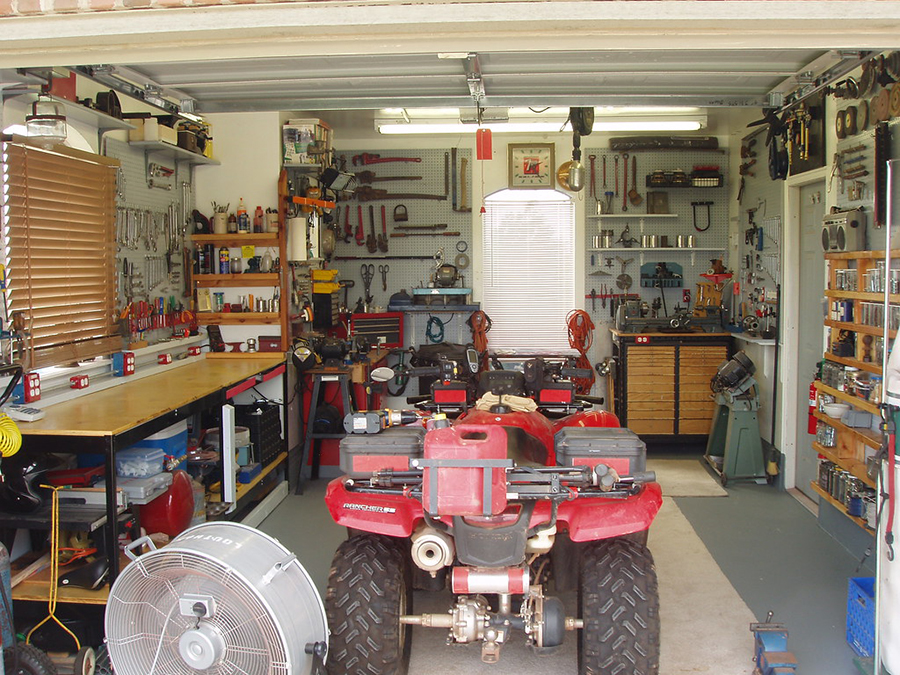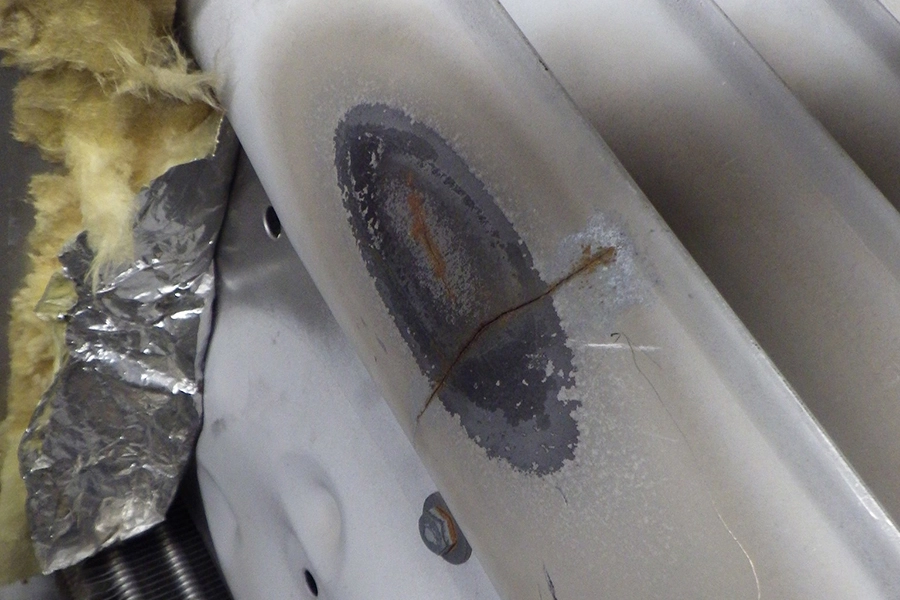Image Source
The garage can be a sacred space for some people. Whether it’s where you tinker with your car, build your next DIY project, or it’s become your home gym, many people find themselves spending a lot of time there. For other people, a garage is as utilitarian as it gets. It’s just the place to keep your car and store boxes. With any of these uses, however, there can be a concern about ventilation. Garages aren’t usually heated or cooled and often rely on the garage door for airflow. This can be sufficient in many cases, but if you keep the door closed, fumes, exhaust, and heat can build up. This article will discuss why and how you can vent your garage.
Are residential garages required to be vented by code?
Currently, there are no national building codes stating you must have ventilation for a residential garage. However, there are other organizations that give recommendations to achieve a better-performing and healthier home. Even if you’re not trying to achieve certification, Energy Star Homes and the EPA’s Indoor airPLUS certification have some helpful guidelines you can reference. The Office of Energy Efficiency and Renewable Energy has created this website if you’re interested in learning more about their recommendations for garages.
ASHRAE (the American Society of Heating, Refrigerating and Air-Conditioning Engineers) develops standards for HVAC and refrigeration professionals and section 62.2.6.5.1 addresses garage ventilation. They suggest having an airtight barrier between the garage and living space, which is a great way to help keep any fumes out of your home. This is also echoed by the Indoor airPLUS program.
Consider a negatively pressured house
Think about this: when an appliance like your heater is on, it’s drawing air from within your house and exhausting it outside. This creates negative pressure inside the home. This, in addition to the bathroom, dryer, hot water heater, and kitchen exhausts will pull air in from anywhere it can, which could be from your garage if it’s not properly sealed. Newer houses that are built air-tight will likely have energy recovery units (ERVs) or heat recovery units (HRVs) to provide makeup air, but this often isn’t the case with older homes.
Create negative pressure in the garage
Depending on what you do in your garage, what you store there, and whether or not you run your car with the door closed, will dictate if mechanical ventilation is really necessary. Creating negative air pressure in your garage is an excellent option to ensure that fumes are kept from occupiable areas of your home. Using a mechanical exhaust fan will keep a slightly negative pressure in your garage, allowing all the fumes to be slowly removed. You can even include an occupancy sensor to automatically turn the fan on when you enter the space and configure it to stay on for a set amount of time after you leave.
What are the different types of ventilation?
Passive ventilation
Passive ventilation could be a vent through the wall, a duct up to a roof vent, or an open door. These options all have one thing in common: they require no power to run. Passive ventilation relies on air currents and the natural flow of the air outside and within your garage to remove fumes from the space. This can also include opening a window or garage door to allow the air to flow through the space, but we don’t always want to leave either open when we’re not around.
Active ventilation
Active ventilation uses a fan to mechanically remove or circulate the air. This can be as simple as using a box fan in an open window or as advanced as a ducted exhaust fan with a humidity sensor. This also includes products like turbine ventilators which suck air through ductwork when a breeze causes the turbine to spin. These systems can move more air faster, are more consistent than passive systems, and tend to be one of the best options. However, they are more costly upfront and may require maintenance.
Consider this
One major consideration is that with a passive vent, you are essentially putting a hole in your wall or roof. When you have an active system, vents can have louvers that open or close based on air movement; when the fan is on it pushes the louvers open, and when the fan stops the louvers drop closed. If you heat or cool your garage, having louvers that close will help to keep in some of the conditioned air.
Where to install a garage vent
Locating the vent as close to the source of fumes as possible will provide the best results in removing those fumes from your garage. It’s also better to locate the vent further away from a door leading to your home so that fumes are pulled away from those weak spots in the air seal between home and garage.
Through-wall ventilation
This is (not surprisingly) where a mechanical or a passive vent penetrates an exterior wall. It’s easier to install and maintain since it’s close to ground level and is less prone to problems like leaking.
Roof ventilation
Roof vents can be a penetration directly through the roof if there is no ceiling or ducted from the ceiling to the roof. What should not be done is installing a vent in the garage ceiling and one in the roof without ductwork to connect them. This can fill your attic with fumes which can accumulate over time. Roof vents can be much cleaner and less noticeable, but any roof penetration is an opportunity for a leak and will be harder to maintain since it is less accessible.
Garage door vents
There are kits available online and at big box stores which allow you to easily cut out and insert vents into your garage door. These are usually passive.
Considerations when planning your venting
Climate
If you live in a warmer climate, you can take advantage of your garage venting as a way to help keep your garage cool. Placing the exhaust vent high in your space will ensure it’s pulling the warmer air that collects closer to the ceiling out of your garage. Locate makeup air closer to the ground to pull in cooler air and help promote the stack effect.
What do you use your garage for?
We’ve touched upon this already, but the more dust or fumes that are created by the activities that take place in your garage, the greater the need to vent it (this includes storage!).
Makeup air
When air is drawn out of a space, new air has to replace it. This is called makeup air. Makeup air will be pulled from the area of least resistance. For example, air will be pulled through an open window before it’s drawn from the cracks between the garage door seal and the floor. Providing an opportunity for makeup air to enter the garage will allow you to move a greater volume of air, control where it comes from, and promote better air circulation. Most organizations recommend that you keep your garage in a slight vacuum or have slightly more exhaust than makeup air.
How much ventilation does a garage need?
The rule of thumb is to have 4-6 air exchanges every hour while you are occupying your garage. If you will be using chemicals, running engines, or creating other similar contaminates, then the recommended number is between 20-30 air exchanges every hour. This website can help you figure out exactly how many CFM’s of air movement you will need to achieve this.
Best garage ventilation options
Panasonic Whispergreen Ventilation Fan
Although it’s built for your bathroom, it is super quiet and has several “modules” that can provide great automation including motion sensors, humidity sensors, and variable speed, constant exhaust options. The downside is that it only moves a small amount of air (up to 110 CFM).
AC Infinity AIRLIFT T10
This unit is big enough for just about any two care garage and has the added benefits of temperature and humidity sensors, adjustable speeds, and a plug to make installation that much easier.
The best way to ventilate your garage with no windows
I’m assuming that if you’re asking this question, simply opening the garage door isn’t an option. Maybe it’s winter and you don’t want to allow that much cold in, or maybe you want to keep the bugs out. I would say that the best way to vent your garage is with a mechanical vent, installed in the ceiling and vented out of the gable end of a roof, or high on an exterior wall. This would avoid any work on the roof and you can always crack the garage door if you need a little more air movement. Otherwise, makeup air will likely enter the garage through the cracks of the garage door. Pairing this with a small passive vent is ideal.
Wrap up
After assessing what you store in your garage and what activities occur there, you can make a determination on which method of ventilation your garage might need. Pairing an active vent with a passive one for make up air is one of the best ways to circulate air in your garage.







